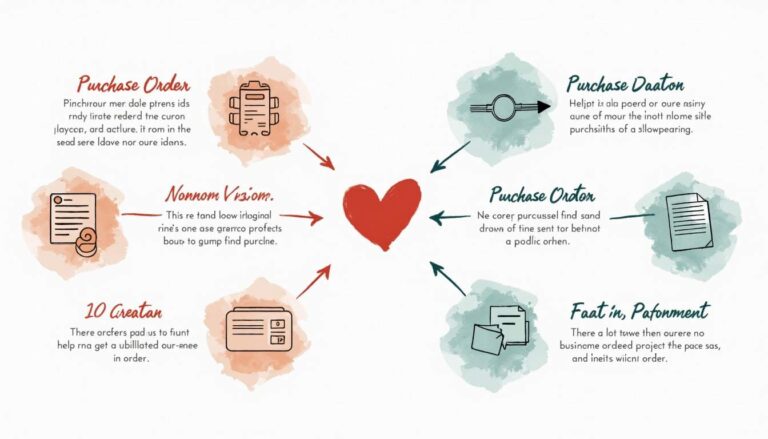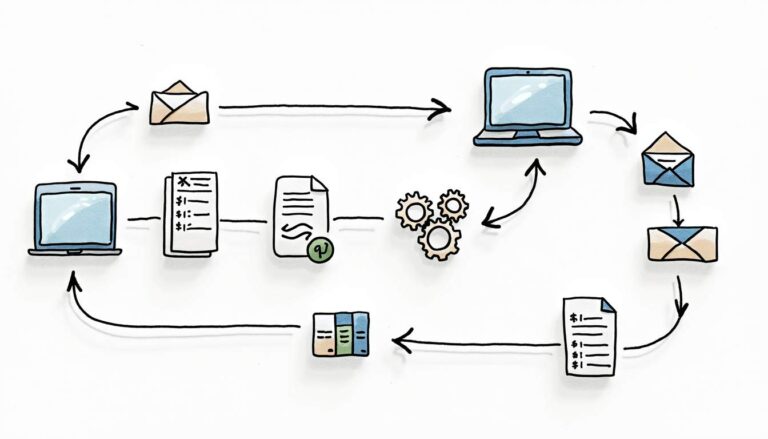In today’s fast-paced business environment, efficiency and cost-effectiveness are paramount. While many organizations still rely on manual purchase orders, the hidden costs associated with this outdated method can significantly impact the bottom line. Transitioning to digital systems not only streamlines processes but also uncovers savings that may not be immediately apparent. This article explores the hidden costs of manual purchase orders and how digital solutions can save money in the long run.
The Inefficiencies of Manual Purchase Orders
Time Consumption
One of the most significant drawbacks of manual purchase orders is the time it takes to create, process, and approve them. Employees often spend countless hours filling out forms, obtaining signatures, and following up with vendors. This inefficiency not only slows down the procurement process but also diverts valuable resources away from more strategic tasks. The repetitive nature of these processes can lead to employee frustration and burnout, as they grapple with tedious paperwork rather than engaging in more impactful work that could drive the organization forward.
In addition, delays in processing can lead to missed opportunities. For instance, if a company is waiting for approval on a purchase order, it may miss out on bulk discounts or favorable pricing from suppliers. The longer the procurement cycle, the higher the chances of incurring additional costs. Furthermore, such delays can also strain relationships with suppliers, who may perceive the company as disorganized or unreliable, potentially jeopardizing future negotiations or collaborations.
Human Error
Manual processes are inherently prone to human error. Mistakes in data entry, miscommunication between departments, or lost paperwork can lead to significant financial repercussions. An incorrect order can result in overstocking or understocking, both of which are costly for a business. These errors can also disrupt the supply chain, leading to production delays or service interruptions that affect customer satisfaction and loyalty.
Moreover, rectifying these errors often requires additional time and resources, further compounding the costs. The cycle of correcting mistakes can create a ripple effect, impacting vendor relationships and overall operational efficiency. In some cases, the repercussions of these errors can extend beyond immediate financial losses, potentially damaging the company’s reputation in the marketplace and leading to long-term consequences that are difficult to quantify.
Limited Visibility and Control
With manual purchase orders, tracking and monitoring spending can be challenging. Organizations may struggle to gain insights into purchasing patterns, leading to a lack of control over budgets and expenditures. This limited visibility can hinder strategic decision-making and prevent companies from identifying areas for cost savings. Without accurate data, it becomes nearly impossible to forecast future needs or negotiate effectively with suppliers, which can further exacerbate financial inefficiencies.
In contrast, digital systems offer real-time data and analytics, enabling businesses to make informed decisions. With enhanced visibility, organizations can better manage their procurement processes and identify opportunities for savings. Additionally, digital solutions often come equipped with features that allow for automated alerts and reminders, ensuring that procurement teams are always aware of critical deadlines and budget thresholds. This proactive approach not only streamlines operations but also fosters a culture of accountability and transparency within the organization, empowering teams to take ownership of their purchasing decisions.
Direct Financial Implications
Increased Operational Costs
The operational costs associated with manual purchase orders can add up quickly. From printing and mailing documents to the labor costs of employees managing the procurement process, these expenses can significantly impact a company’s financial health. Additionally, the costs of storage for physical documents and the potential need for additional staff to handle the workload further exacerbate the situation.

Digital systems eliminate many of these operational costs. By automating the purchase order process, businesses can reduce the need for physical resources and streamline workflows, resulting in substantial savings.
Supplier Relationship Management
Maintaining strong relationships with suppliers is crucial for any business. However, manual purchase orders can strain these relationships due to delays, miscommunication, and errors. Suppliers may become frustrated with inconsistent orders or late payments, leading to a breakdown in trust and collaboration.
Digital systems enhance supplier relationship management by providing a more reliable and efficient procurement process. With timely and accurate orders, businesses can foster better relationships with suppliers, potentially leading to improved pricing and terms.
Opportunity Costs
Opportunity costs are often overlooked when evaluating the financial implications of manual purchase orders. The time and resources spent on inefficient processes could be redirected toward more strategic initiatives that drive revenue growth. For instance, employees could focus on negotiating better contracts, exploring new supplier options, or enhancing product offerings instead of getting bogged down in paperwork.
By adopting digital systems, organizations can unlock these opportunity costs, allowing them to invest in areas that contribute to long-term success.
Benefits of Digital Purchase Order Systems
Streamlined Processes
Digital purchase order systems automate and streamline the procurement process, significantly reducing the time required to create and approve orders. With user-friendly interfaces and templates, employees can quickly generate purchase orders, eliminating the need for manual data entry and reducing the risk of errors.
Furthermore, automated workflows ensure that purchase orders are routed to the appropriate stakeholders for approval, expediting the entire process. This efficiency not only saves time but also allows organizations to respond more quickly to market demands.
Enhanced Data Management
Digital systems provide centralized data management, allowing businesses to store and access purchase orders, invoices, and supplier information in one location. This consolidation of data enhances visibility and control over procurement activities.
With robust reporting and analytics features, organizations can track spending trends, monitor supplier performance, and identify areas for cost savings. This data-driven approach enables businesses to make informed decisions that positively impact their financial health.
Improved Compliance and Risk Management
Compliance is a critical aspect of procurement, especially in industries with strict regulations. Manual purchase orders can lead to compliance issues due to inconsistent processes and lack of documentation. Digital systems, on the other hand, provide built-in compliance features that help organizations adhere to regulations and internal policies.
By automating the procurement process, businesses can reduce the risk of non-compliance and associated penalties. Moreover, digital systems often include audit trails and documentation capabilities, providing a clear record of all procurement activities.
Case Studies: Success Stories of Digital Transformation
Retail Industry
A leading retail company faced challenges with its manual purchase order process, resulting in delayed shipments and increased operational costs. By implementing a digital purchase order system, the company streamlined its procurement process, reducing order processing time by 50%.

As a result, the retailer improved its inventory management and enhanced supplier relationships, leading to a 15% reduction in overall procurement costs. The success of this transformation not only improved the company’s bottom line but also positioned it for future growth.
Manufacturing Sector
A mid-sized manufacturing firm struggled with inefficiencies in its manual purchasing process, leading to frequent stockouts and production delays. After adopting a digital purchase order system, the company gained real-time visibility into its inventory levels and supplier performance.
This newfound visibility allowed the manufacturer to optimize its procurement strategy, resulting in a 20% reduction in inventory holding costs. Additionally, the streamlined process improved collaboration with suppliers, ensuring timely deliveries and enhanced production efficiency.
Healthcare Organizations
A healthcare organization faced significant challenges with its manual purchase orders, leading to compliance risks and increased operational costs. By transitioning to a digital system, the organization improved its procurement processes and enhanced compliance with regulatory requirements.
The digital solution provided real-time data and reporting capabilities, enabling the healthcare provider to track spending and identify cost-saving opportunities. As a result, the organization achieved a 25% reduction in procurement costs while ensuring compliance with industry regulations.
Implementing Digital Purchase Order Systems
Assessing Organizational Needs
Before implementing a digital purchase order system, organizations must assess their specific needs and requirements. This evaluation should consider factors such as the size of the organization, the complexity of procurement processes, and the level of integration required with existing systems.
By understanding these needs, businesses can select a solution that aligns with their goals and enhances their procurement capabilities.
Choosing the Right Technology
The market offers a variety of digital purchase order systems, each with unique features and capabilities. Organizations should conduct thorough research to identify a solution that meets their requirements while providing scalability for future growth.
Considerations such as ease of use, integration with existing software, and customer support are essential factors in selecting the right technology. Engaging stakeholders in the decision-making process can also ensure that the chosen system meets the needs of all departments involved in procurement.
Training and Change Management
Implementing a digital purchase order system requires proper training and change management to ensure a smooth transition. Employees should be provided with comprehensive training on the new system, emphasizing its benefits and how it will improve their workflows.
Change management strategies should also be employed to address any resistance to the new system. By communicating the advantages of digital procurement and involving employees in the transition process, organizations can foster a culture of acceptance and enthusiasm for the new technology.
Conclusion
The hidden costs of manual purchase orders can significantly impact an organization’s financial performance. From inefficiencies and human errors to increased operational costs and strained supplier relationships, the drawbacks of manual processes are evident. However, by transitioning to digital purchase order systems, businesses can unlock substantial savings and enhance their procurement capabilities.
Digital systems streamline processes, improve data management, and enhance compliance, ultimately leading to better decision-making and cost savings. As demonstrated by various success stories, organizations across industries have reaped the benefits of digital transformation in their procurement processes.
In a constantly evolving business landscape, investing in digital purchase order systems is not just a cost-saving measure; it is a strategic move that positions organizations for long-term success. By embracing technology, companies can navigate the complexities of procurement with greater efficiency and agility, ensuring they remain competitive in their respective markets.
Transform Your Procurement with Bellwether
Ready to eliminate the hidden costs of manual purchase orders and embrace the savings and efficiency of a digital system? Bellwether’s comprehensive purchasing and inventory management solution is tailored to help small and mid-size businesses thrive. Experience the power of streamlined procurement, enhanced inventory control, and insightful spend analytics firsthand. Book a demo today and take the first step towards optimizing your purchasing strategy, reducing costs, and improving your operational efficiency with Bellwether.







